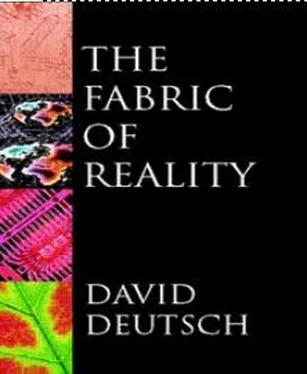David Deutch - The Fabric of Reality
Здесь есть возможность читать онлайн «David Deutch - The Fabric of Reality» весь текст электронной книги совершенно бесплатно (целиком полную версию без сокращений). В некоторых случаях можно слушать аудио, скачать через торрент в формате fb2 и присутствует краткое содержание. ISBN: , Жанр: Физика, Философия, на английском языке. Описание произведения, (предисловие) а так же отзывы посетителей доступны на портале библиотеки ЛибКат.
- Название:The Fabric of Reality
- Автор:
- Жанр:
- Год:неизвестен
- ISBN:0-7139-9061-9
- Рейтинг книги:4 / 5. Голосов: 2
-
Избранное:Добавить в избранное
- Отзывы:
-
Ваша оценка:
- 80
- 1
- 2
- 3
- 4
- 5
The Fabric of Reality: краткое содержание, описание и аннотация
Предлагаем к чтению аннотацию, описание, краткое содержание или предисловие (зависит от того, что написал сам автор книги «The Fabric of Reality»). Если вы не нашли необходимую информацию о книге — напишите в комментариях, мы постараемся отыскать её.
The Fabric of Reality — читать онлайн бесплатно полную книгу (весь текст) целиком
Ниже представлен текст книги, разбитый по страницам. Система сохранения места последней прочитанной страницы, позволяет с удобством читать онлайн бесплатно книгу «The Fabric of Reality», без необходимости каждый раз заново искать на чём Вы остановились. Поставьте закладку, и сможете в любой момент перейти на страницу, на которой закончили чтение.
Интервал:
Закладка:
Again we were too parochial, and were led to the false conclusion: that knowledge-bearing entities can be physically identical to non knowledge-bearing ones; and this in turn cast doubt on the fundamental status of knowledge. But now we have come almost full circle. We can see that the ancient idea that living matter has special physical properties was almost true: it is not living matter but knowledge-bearing matter that is physically special. Within one universe it looks irregular; across universes it has a regular structure, like a crystal in the multiverse.
So knowledge is a fundamental physical quantity after all, and the phenomenon of life is only slightly less so.
Imagine looking through an electron microscope at a DNA molecule from a bear’s cell, and trying to distinguish the genes from the non-gene sequences and to estimate the degree of adaptation of each gene. In any one universe, this task is impossible. The property of being a gene — that is, of being highly adapted — is, in so far as it can be detected within one universe, overwhelmingly complicated. It is an emergent property. You would have to make many copies of the DNA, with variations, use genetic engineering to create many bear embryos for each variant of the DNA, allow the bears to grow up and live in a variety of environments representative of the bear’s niche, and see which bears succeed in having offspring.

FIGURE 8.1 Multiverse view of two DNA segments which happen to be identical in our universe, one random and one from within a gene.
But with a magic microscope that could see into other universes (which, I stress, is not possible: we are using theory to imagine — or render — what we know must be there) the task would be easy. As in Figure 8.1, the genes would stand out from the non-genes just as cultivated fields stand out from a jungle in an aerial photograph, or like crystals that have precipitated from solution. They are regular across many nearby universes, while all the non-gene, junk-DNA segments are irregular. As for the degree of adaptation of a gene, this is almost as easy to estimate. The better-adapted genes will have the same structure over a wider range of universes — they will have bigger ‘crystals’.
Now go to an alien planet, and try to find the local life-forms, if any. Again, this is a notoriously difficult task. You would have to perform complex and subtle experiments whose infinite pitfalls have been the subject of many a science-fiction story. But if only you could observe through a multiverse telescope, life and its consequences would be obvious at a glance. You need only look for complex structures that seem irregular in any one universe, but are identical across many nearby universes. If you see any, you will have found some physically embodied knowledge. Where there is knowledge, there must have been life, at least in the past.
Compare a living bear with the Great Bear constellation. The living bear is anatomically very similar in many nearby universes. It is not only its genes that have that property, but its whole body (though other attributes of its body, such as its weight, vary much more than the genes; that is because, for example, in different universes the bear has been more or less successful in its recent search for food). But in the Great Bear constellation there is no such regularity from one universe to another. The shape of the constellation is a result of the initial conditions in the galactic gas from which the stars formed. Those conditions were random — very diverse in different universes, at a microscopic level — and the process of the formation of stars from that gas involved various instabilities which amplified the scale of the variations. As a result, the pattern of stars that we see in the constellation exists in only a very narrow range of universes. In most nearby variants of our universe there are also constellations in the sky, but they look different.
Finally, let us look around the universe in a similar way. What will catch our magically enhanced eye? In a single universe the most striking structures are galaxies and clusters of galaxies. But those objects have no discernible structure across the multiverse. Where there is a galaxy in one universe, a myriad galaxies with quite different geographies are stacked in the multiverse. And so it is everywhere in the multiverse. Nearby universes are alike only in certain gross features, as required by the laws of physics, which apply to them all. Thus most stars are quite accurately spherical everywhere in the multiverse, and most galaxies are spiral or elliptical. But nothing extends far into other universes without its detailed structure changing unrecognizably. Except, that is, in those few places where there is embodied knowledge. In such places, objects extend recognizably across large numbers of universes. Perhaps the Earth is the only such place in our universe, at present. In any case, such places stand out, in the sense I have described, as the location of the processes — life, and thought — that have generated the largest distinctive structures in the multiverse.
replicatorAn entity that causes certain environments to make copies of it.
geneA molecular replicator. Life on Earth is based on genes that are DNA strands (RNA in the case of some viruses).
memeAn idea that is a replicator, such as a joke or a scientific theory.
nicheThe niche of a replicator is the set of all possible environments in which the replicator would cause its own replication. The niche of an organism is the set of all possible environments and life-styles in which it could live and reproduce.
adaptationThe degree to which a replicator is adapted to a niche is the degree to which it causes its own replication in that niche. More generally, an entity is adapted to its niche to the extent that it embodies knowledge that causes the niche to keep that knowledge in existence.
Scientific progress since Galileo has seemed to refute the ancient idea that life is a fundamental phenomenon of nature. It has revealed the vast scale of the universe, compared with the Earth’s biosphere. Modern biology seems to have confirmed this refutation, by explaining living processes in terms of molecular replicators, genes, whose behaviour is governed by the same laws of physics as apply to inanimate matter. Nevertheless, life is associated with a fundamental principle of physics — the Turing principle — since it is the means by which virtual reality was first realized in nature. Also, despite appearances, life is a significant process on the largest scales of both time and space. The future behaviour of life will determine the future behaviour of stars and galaxies. And the largest-scale regular structure across universes exists where knowledge-bearing matter, such as brains or DNA gene segments, has evolved.
This direct connection between the theory of evolution and quantum theory is, to my mind, one of the most striking and unexpected of the many connections between the four strands. Another is the existence of a substantive quantum theory of computation underlying the existing theory of computation. That connection is the subject of the next chapter.
9
Quantum Computers
To anyone new to the subject, quantum computation sounds like the name of a new technology — the latest, perhaps, in the remark able succession that has included mechanical computation, transistorized electronic computation, silicon-chip computation, and so on. And it is true that even existing computer technology relies on microscopic quantum-mechanical processes. (Of course all physical processes are quantum-mechanical, but here I mean ones for which classical physics — i.e. non-quantum physics — gives very inaccurate predictions.) If the trend towards ever faster, more compact computer hardware is to continue, the technology must become even more ‘quantum-mechanical’ in this sense, simply because quantum-mechanical effects are dominant in all sufficiently small systems. If there were no more to it than that, quantum computation could hardly figure in any fundamental explanation of the fabric of reality, for there would be nothing fundamentally new in it. All present-day computers, whatever quantum-mechanical processes they may exploit, are merely different technological implementations of the same classical idea, that of the universal Turing machine. That is why the repertoire of computations available to all existing computers is essentially the same: they differ only in their speed, memory capacity and input-output devices. That is to say, even the lowliest of today’s home computers can be programmed to solve any problem, or render any environment, that our most powerful computers can, provided only that it is given additional memory, allowed to run for long enough, and given appropriate hardware for displaying its results.
Читать дальшеИнтервал:
Закладка:
Похожие книги на «The Fabric of Reality»
Представляем Вашему вниманию похожие книги на «The Fabric of Reality» списком для выбора. Мы отобрали схожую по названию и смыслу литературу в надежде предоставить читателям больше вариантов отыскать новые, интересные, ещё непрочитанные произведения.
Обсуждение, отзывы о книге «The Fabric of Reality» и просто собственные мнения читателей. Оставьте ваши комментарии, напишите, что Вы думаете о произведении, его смысле или главных героях. Укажите что конкретно понравилось, а что нет, и почему Вы так считаете.












